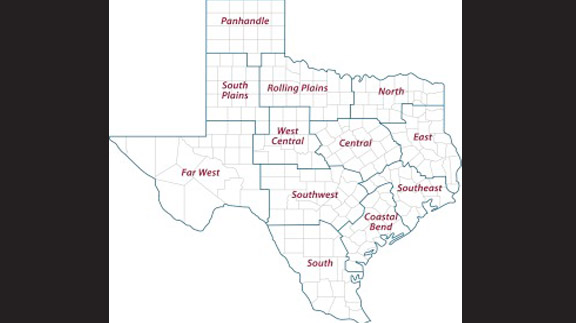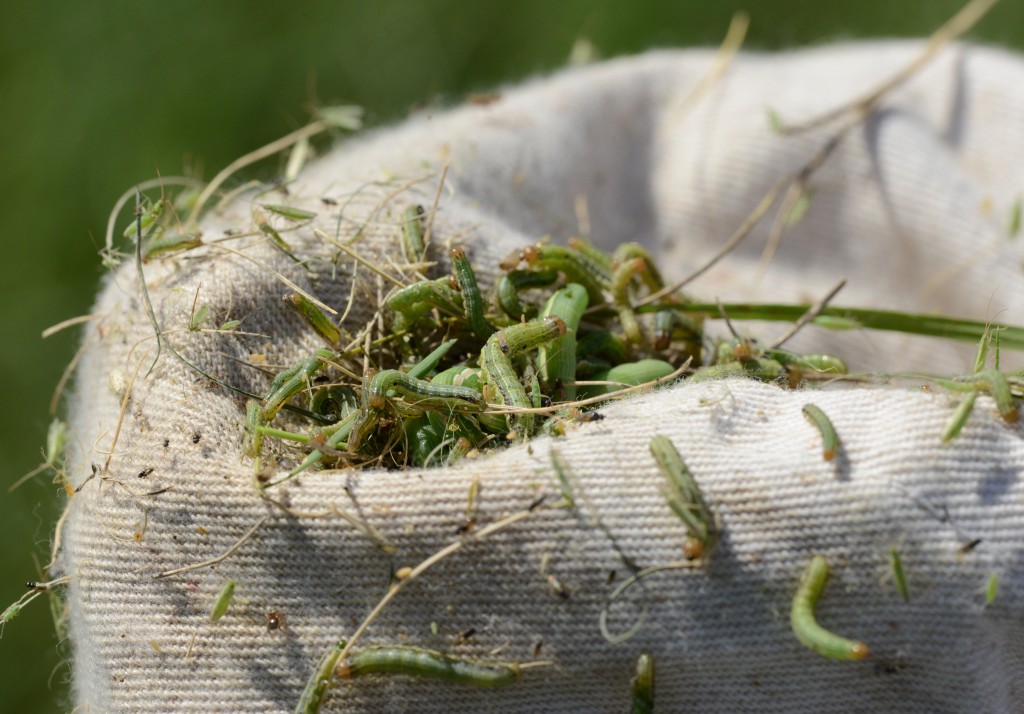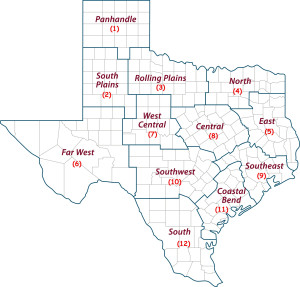Farm & Ranch
Texas crop, weather report for Sept. 1

By: Robert Burns
AgriLife expert: Conditions ripe for armyworm population explosion
Writer: Robert Burns, 903-834-6191, [email protected]
COLLEGE STATION – Dry weather followed by rain in the late summer and early fall means farmers should be on the lookout for fall armyworms, said Dr. Allen Knutson, Texas A&M AgriLife Extension Service entomologist, Dallas.
“Given their immense appetite, great numbers and marching ability, fall armyworms can damage entire fields or pastures in a few days,” Knutson wrote in a recently updated factsheet on the pest, “The Fall Armyworm – Pest of Pasture and Hay – 2015.”
Knutson said it’s a common perception that armyworm infestations of pastures and small grain fields explode overnight.
Download or preview a two-minute MP3 audio version of this report
At this size, they are also much easier to control than when they are nearly mature larvae, which measure 1 inch to 1.5 inches long, he said. Besides, the large larvae do the most damage.
“The key to managing fall armyworms is frequent inspection of fields to detect fall armyworm infestations before they have caused economic damage. Once larvae are greater than three-quarters inch long, the quantity of foliage they eat increases dramatically,” he said. “During their final two to three days of feeding, armyworms consume 80 percent of the total foliage consumed during their entire development.”
The best time to scout for fall armyworms is in the early morning and during cool, cloudy weather, Knutson said. Scouting involves getting down on hands and knees and examining the grass canopy closely for armyworms.
“Sometimes it helps to run your hand roughly through the grass and then pull back the grass to see the armyworms that have fallen to the ground,” he said. “Also, areas of the leaf where the green has been eaten away, leaving only clear leaf tissue, the ‘window pane’ effect, is evidence that armyworms are active in the field. A sweep net also works well to sample fall armyworms.”
AgriLife Extension district reporters compiled the following summaries:
Central: Throughout the region, soil moisture, rangeland and pastures were generally in fair condition. Most crops and livestock were rated as being in good condition. In some areas, the corn and grain sorghum harvests neared completion. Corn yields were from 48 bushels per acre to 198 bushels, with the average about 80 bushels per acre. The cotton harvest was expected to start in the next couple of weeks. Early planted cotton was already being harvested, and cotton gins were up and running. Parts of the region had some light showers. Some counties received damaging winds and hail. Armyworms were bad in irrigated Bermuda grass fields. Ranchers were preparing fields to plant oats and wheat for grazing this fall. Stock tank and creek levels were dropping, but plenty of water remained. Producers were still making hay. Livestock were in good condition.
Coastal Bend: Soil moisture remained short. A little late-planted grain sorghum was still left to be harvested, but otherwise the crop was in the bins. Cotton harvest was proceeding well, both in terms of yield and quality. There were still many fields that had yet to be defoliated. The cotton harvest will stretch out longer this year due to the vast difference in planting dates. Soybeans were being harvested. The ratoon rice crop looked good. Rangeland and pastures were declining with the hot, dry weather. Cattle remained in good condition.
East: Most of the region got at least a little rain and cooler temperatures. Henderson County received 1 inch to 2 inches, which helped soil moisture. Most counties rated subsoil and topsoil moisture as short to adequate. Lake and pond levels were holding steady. Panola County had scattered heavy rains with cooler temperatures, but burn bans remained in place. Where the rains came, some pastures were starting to green back up, and producers were hoping to get one more cutting of hay. Trinity County did not receive any rain, and soils were drying out quickly. Some producers were looking for hay to purchase. They will likely have to go outside the county to find it. Most producers needed one or two more cuttings of hay to meet this winter’s demand. Armyworms were already attacking some fields. In Wood County, livestock producers were providing supplemental feed to cattle. Producers were planting winter pasture grasses. Outdoo rsmen and hunters were planting wildlife food plots.
Far West: Pastures and rangeland remained in fair to good condition. Topsoil and subsoil moisture ranged from adequate to very short. Cotton was setting bolls and squaring. Glasscock County sorghum was 100 percent mature and 50 percent harvested. All Upton County grain sorghum was headed out, and 15 percent was mature. Sunflowers were being harvested in Glasscock County. Many areas only received light scattered showers, except for Ward County, which got 2.5 inches. Producers began working cattle. Livestock were in good condition with continued supplemental feeding.
North: Topsoil moisture was short to very short. The weather was a little cooler with some spotty showers. Temperatures remained in the mid-90s for most of the week. The corn harvest continued, with yields far below average. Grain sorghum neared being ready for harvest. Soybeans struggled with the heat and lack of moisture. Summer pastures and hay meadows were in desperate need of rain. Ponds needed runoff water. Cattle were showing early adaptations to the coming cool weather as their hair coats started growing. Summer insect pests weren’t too bad this summer. There was a slight increase in sugarcane aphids counts, but they were not enough to warrant spraying. The feral hog population appeared to be increasing.
Panhandle: The region was mostly hot and dry with near-average temperatures. Soil moisture was rated fair to adequate. Collingsworth County cotton was maturing and loading up with bolls. Summer crops in Dallam and Hartley counties were progressing well, with irrigation active. The corn silage harvest began, and the harvesting of potatoes and watermelons was ongoing. Many grain sorghum producers had to spray to control sugarcane aphids. Field preparation for wheat planting continued, but grasshopper pressure was so bad, planting will likely be delayed. Deaf Smith County received hail yet again, and producers were trying to recover. In some cases, insurance adjusters have had to visit the same fields for the second and third time. Corn, sunflowers, grain sorghum and hay crops were all affected, with some of the heavier storms leaving just pieces of stalks. Producers sprayed for sugarcane aphid after the bad weather. Hansford C ounty received from a trace to about 0.7 inch of rain. Some producers started harvesting silage. Producers were able to turn off irrigation of some corn, but late-planted fields may need watering for another two weeks. Dryland grain sorghum was mostly headed out and looked good. Irrigated grain sorghum looked good too, and sugarcane aphids were mostly under control. Irrigated cotton looked good; dryland cotton looked spotty in some areas and great in others. Hemphill County received 2 to 3 inches during the last couple of weeks. Pastures stayed green and were in excellent shape. In Sherman County, early planted corn looked great; later-planted corn looked good but needed some more heat units. Producers have consistently had to spray for grasshoppers, mites and earworms. Cotton looked good, but growth regulators didn’t stop it from growing and maturing early. This will hurt the crop in the long run because, regardless of when the first freeze comes, there won’t be time for i t to completely mature. Grain sorghum looked great but needed some more heat units. Sugarcane aphids were found, and producers started spraying to control the pest. Some producers began planting wheat.
Rolling Plains: The region remained dry. Only a few areas received any measurable rainfall during the past three to four weeks, and high temperatures hovered around 100 degrees. Pastures and cotton fields were beginning to show signs of moisture stress. With the abundance of dry grasses and hot weather, producers were beginning to worry about wildfire. Livestock were in good condition, with some producers providing supplemental feed while others were rotating cattle to pastures that had not been grazed yet. Cotton was in fair to good shape. It would be in great shape if moisture is received in the next week or two. Plants are loaded with bolls, but if the dry weather persists, they are likely to begin dropping fruit. Some producers continued to fertilize wheat, while others were waiting to fertilize when they plant. Pecans needed moisture. Grasshopper populations were still high.
South: Hot and humid conditions continued throughout the region. Only the southern counties received rain. In the northern part of the region, cotton was doing well, and peanuts, which were under only low disease pressure, looked good. Strawberry growers were preparing to plant. In Frio County, harvesting of early planted cotton began. In McMullen County, declining rangeland and pastures kept ranchers busy weaning herds to lessen the grazing pressure. Soil moisture was short to very short throughout the northern counties. In the eastern part of the region, cotton was maturing and opening bolls in some areas. Harvesting was expected to begin sometime next week. In others areas, cotton harvesting was about half done. The demand for replacement cattle continued. In Kleberg and Kenedy counties, corn harvesting was completed. Soil moisture was short to very short throughout most of the eastern counties. The exception was Jim We lls County where soil moisture was 50 percent adequate. In the western part of the region, rangeland and pastures further declined. Dimmit County had isolated wildfires. In Maverick County, temperatures were in the lower 90s, pecan orchards were in good condition, and most forage sorghum was harvested. In Zavala County, corn harvesting was completed, and oat and wheat planting was expected to begin within the next 10 to 15 days. Also, farmers were preparing seedbeds for planting spinach, cabbage and onions. Soil moisture was short to very short through the western counties. In the southern part of the county, rains temporarily halted cotton harvesting. Hay harvesting continued where weather permitted, and planting of fall onions, peppers and tomatoes began in Cameron County. In Starr County, preparations for fall vegetable planting continued, and hay baling operations slowed with the threat of rain in the forecast. Soil moisture was 90 percent short in Cameron County, 80 to 100 perc ent adequate in Hidalgo County and 90 percent adequate in the Starr County area.
South Plains: Floyd County dryland crops needed rain, having suffered through a mostly dry August. Producers began harvesting early planted corn. In Bailey County, the corn silage harvest continued with good yields reported. Cochran County subsoil and topsoil moisture was low. Producers continued to irrigate crops. The corn harvest began. Cotton, peanuts, peas, sunflowers and sorghum crops continued to mature. Pasture and rangeland were in fair to adequate condition. Parts of Lubbock County received isolated, light showers. Irrigation was ongoing but should wind down soon. No open bolls were observed yet in June-planted cotton, but earlier planted cotton should open bolls soon. The sorghum harvest began. Garza County received from a trace to nearly 1 inch of rain. The rain was accompanied by high winds and lightning. The lightning started wildfires in the northeast part of the county. Four separate fires burned approximately 1,500 acres. Though threatened by wildfire, rangeland was mostly in excellent condition. Parts of Scurry County received light, scattered showers. Cotton was stressed.
Southeast: Soil-moisture levels throughout the region were mostly short to very short with short being the most common. However, Fort Bend and San Jacinto counties reported 100 percent adequate levels. Rangeland and pasture ratings varied widely too, mostly from fair to poor, with fair ratings being the most common. Many counties received varying amounts of rain. Walker County received scattered showers but still needed more moisture. Montgomery County also received a few showers mid-week, from 0.5 inch to 2 inches of rain in various locations. The moisture really greened up the pastures. Waller County received 1 inch to 3 inches of rain, which helped pastures and kept cattle in good condition. However, livestock were taking refuge in ponds because of triple-digit temperatures. The corn harvest was almost complete. The Chambers County rice harvest was progressing under favorable weather conditions. Rains early in the week helpe d pastures and grass to somewhat recover from drought-like conditions. In Fort Bend County, cotton producers started defoliating; some started picking the last weekend of July. With rain expected the first week of August, other producers may hold off on defoliation. Livestock were in good condition, once grass started growing again. Galveston County received heavy rains for several days.
Southwest: Dry weather continued, with rangelands and pastures taking the biggest hit. Brush was stressed as well. Producers were worried about potential wildfires. The small grain harvest continued, and the grape harvest began. Cotton was rated as being in fair condition but had a considerable amount of root rot. All corn was harvested. Although available forage quality declined, wildlife and livestock remained in good condition. Deer looked big and healthy as hunting season approached.
West Central: Days were mostly hot, dry and windy. A few areas got scattered showers, but most areas remained very dry. Soil moisture continued to be rapidly depleted. There was extremely high wildfire danger in areas that have fields with tall, dry forage and high winds. Burn bans remained in effect in all counties. Producers were gearing up to begin planting early fall wheat for grazing. Some planting was expected to begin Sept. 1. Cotton was progressing well in some areas and mostly in good condition. In other areas, dryland cotton was severely stressed by lack of moisture and high temperatures, and irrigated cotton was struggling. The grain sorghum harvest neared completion. Producers were taking more hay cuttings, though yields were lower than seen early in the summer due to the extremely dry conditions. Rangeland and pastures were drying up. Livestock remained in fair to good condition. Pecans seemed to be doing well, though the varieties that would normally drop nuts in August did so in late July.
-30-
Find more stories, photos, videos and audio at http://today.agrilife.org
Farm & Ranch
Acorn Toxicity

By Barry Whitworth, DVM, MPH
With the prolonged drought, most pastures in Oklahoma end up in poor condition. With the lack of available forage, animals may go in search of alternative foods.
If oak trees are in the pastures, acorns may be a favorite meal for some livestock in the fall. This may result in oak poisoning.
Oak leaves, twigs, buds, and acorns may be toxic to some animals when consumed.
To read more, pick up a copy of the November edition of North Texas Farm & Ranch magazine, available digitally and in print. To subscribe by mail, call 940-872-5922.

Farm & Ranch
Silver Bluestems

By: Tony Dean
There are a handful of grasses on North Texas grazing lands ranchers need to know, not because they are highly desirable, but rather because they are not of much value. I call them “decom” plants, which is am acronym for “Don’t Ever Count On Me.” Silver bluestem is a “decom” grass.
Silver bluestem is a perennial which grows in all areas of Texas. It can survive in almost all soil types, and in full sun conditions or in semi shade. It grows up to three feet tall and is easily recognized with the presence of the white fuzzy seed head. Also, one of the identifying characteristics of Silver bluestem is a bend in the stems at each node, causing the plants to take on a rounded shape as they mature.
To read more, pick up a copy of the November edition of North Texas Farm & Ranch magazine, available digitally and in print. To subscribe by mail, call 940-872-5922.

Farm & Ranch
Meanwhile Back At The Ranch

By: Rayford Pullen
Fall is here which means winter is closing in on us and before we officially get into winter, we need to make sure our factories are either producing or will be producing in a few months.
We have been pregnancy testing our cows this fall and if they are not bred or nursing a calf, we are bidding them adios. With annual costs somewhere between $900.00 and $1,000.00 per cow, those cows not producing a live weaned calf are costing us quite a bit.
To read more, pick up a copy of the November edition of North Texas Farm & Ranch magazine, available digitally and in print. To subscribe by mail, call 940-872-5922.
-

 Country Lifestyles2 years ago
Country Lifestyles2 years agoScott & Stacey Schumacher: A Growth Mindset
-

 Country Lifestyles8 years ago
Country Lifestyles8 years agoStyle Your Profile – What your style cowboy hat says about you and new trends in 2017
-

 HOME8 years ago
HOME8 years agoGrazing North Texas – Wilman Lovegrass
-

 Equine1 year ago
Equine1 year agoThe Will to Win
-

 Country Lifestyles5 years ago
Country Lifestyles5 years agoAmber Crawford, Breakaway Roper
-

 Outdoor9 years ago
Outdoor9 years agoButtercup or Primrose?
-

 Country Lifestyles8 years ago
Country Lifestyles8 years agoJune 2016 Profile – The man behind the mic: Bob Tallman
-

 Country Lifestyles8 years ago
Country Lifestyles8 years agoDecember 2016 Profile, Rusty Riddle – The Riddle Way






